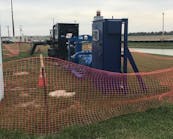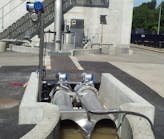AdEdge Water Technologies LLC
undefined
The Red Rock Correctional Center complex was originally built in 2006 outside Eloy, Ariz., by the Corrections Corporation of America (CCA) to house inmates for the state of California. In 2013, CCA agreed to a contract with the state of Arizona to administer up to 1,500 prisoners at Red Rock, and relocated its California inmates to other CCA locations.
The new Arizona contract, however, presented a complication for CCA. The raw water in the well that supplies the facility was found to have approximately 870 mg/L total dissolved solids (TDS), which was significantly in excess of Arizona’s requirement of less than 500 mg/L TDS. “There’s a [water quality] requirement by Arizona, and because it’s an Arizona contract at that prison, it needed to be addressed,” said Amy Johnson, wastewater administrative clerk for CCA.
“They did an evaluation of the site, and they determined that the way to meet that requirement was to use a reverse osmosis (RO) system,” said Douglas Craver, western regional sales manager for AdEdge Water Technologies. AdEdge was then invited to participate in the bidding process.
Solution
AdEdge won the bid and created a custom ADRO8-4L-5H RO system to address the facility’s TDS problem. “The system was designed to produce 80 gpm of permeate flow—the RO-treated water—and it blends 60 gpm of raw water back to the permeate, so the system ultimately produces 140 gpm of blended water,” Craver said.
The system is integrated into the center’s well pump and atmospheric storage tanks, so the RO process occurs when water is needed to refill the storage tank. In addition, the system includes an antiscalant feed system that protects the RO membranes from fouling by removing water hardness and silica. A second chemical feed doses sodium hydroxide with the blended product in order to increase its pH, which helps reduce the potential for corrosion in the piping system. A pH controller is interfaced to the RO and chemical feed pump to maintain a final pH in the 7.5 to 7.6 range.
The system also features a clean-in-place (CIP) system, which permits the RO membranes to be cleaned on site without removing them from the pressure vessels. Red Rock’s system operators were trained to monitor the system’s operating pressure and flow rates, so when certain conditions are met, the CIP cycle—which includes the use of low- and high-pH cleaners to remove biofilm and organic scaling caused by hardness and silica in the raw well water—is performed.
Results
The Red Rock Correctional Center’s custom RO system by AdEdge was activated in January 2014. It delivered treated water with TDS of approximately 460 mg/L, reducing the raw well water’s TDS by more than 47 percent and meeting Arizona’s water quality standards.
However, the project was not quite complete. “[The facility] started taking on more prisoners,” Craver said. “They were beginning to realize that they needed
to [either] add a second RO system or expand this RO system, so approximately 10 months after the initial unit was installed, they issued a contract to AdEdge to double the size of the system.”
Fortunately AdEdge had custom-designed the ADRO8-4L-5H system to allow field upgrades as needed. “We did all the upgrades on site with the existing unit running,” Craver said. “We had to create some unique design items to allow the existing RO to keep running while we upgraded the system at the same time.
“The existing pump and the existing filter housing were pulled off the main skid and were temporarily mounted on the concrete pad, and that was allowed to stay plumbed so [the facility] could continue operating,” said Craver. This allowed AdEdge to mount the new pump, a new pre-filter housing, new feed piping and other equipment.
The expansion process took one month and was completed in early 2015. It effectively doubled the system’s output without any reduction in the treated water’s quality. “The system is now producing 160 gpm of permeate water and blending 120 gpm, so that’s a total of 280 gpm that the unit’s producing now,” Craver said. “It’s still maintaining the same TDS [levels] as before.”
“The RO system is meeting the standard that we need to reduce the TDS levels that we have in our well, and it operates like it should,” said Jack Cook, CCA’s water and wastewater supervisor at Red Rock.



